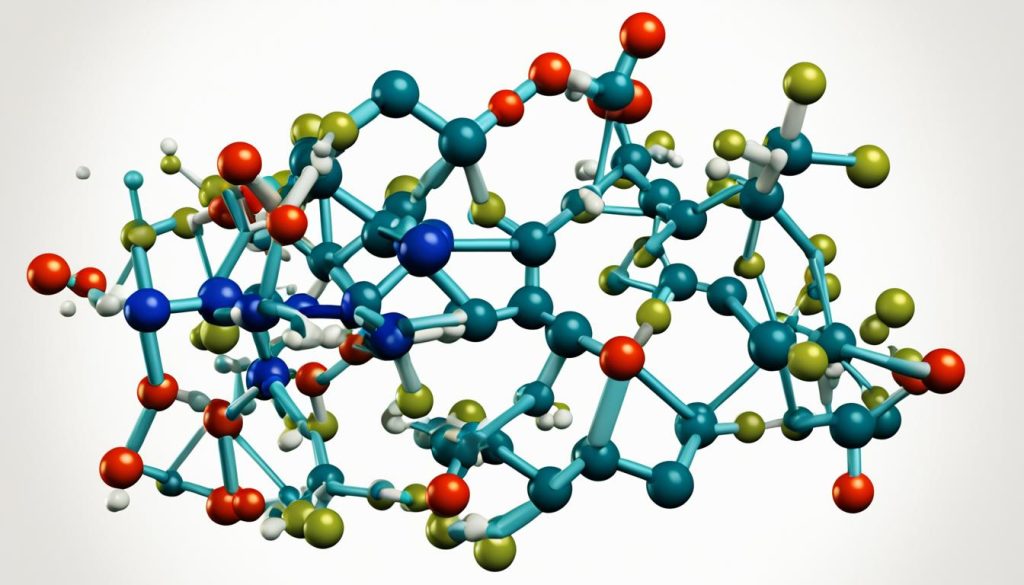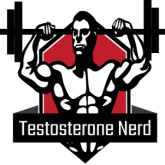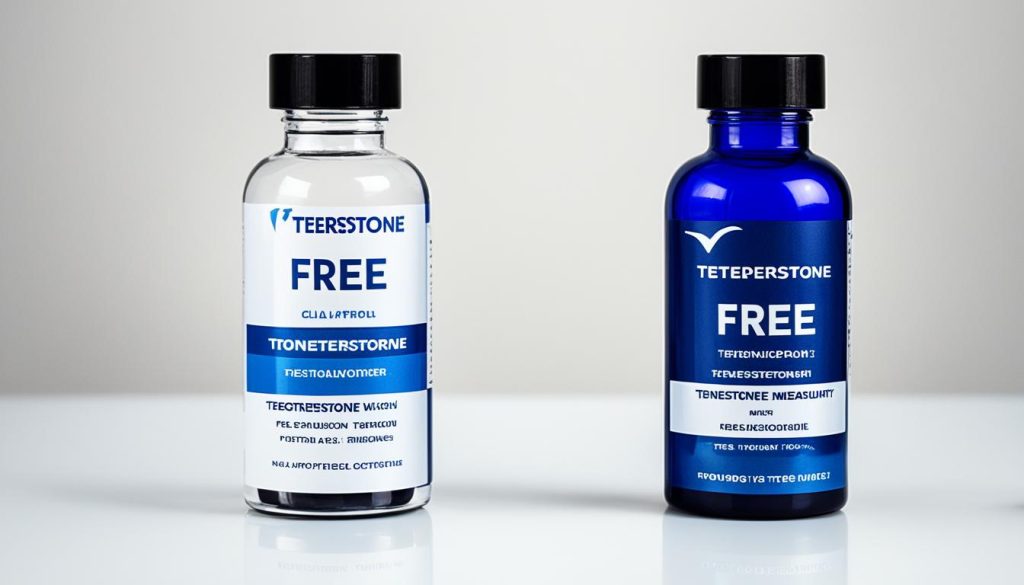Hello, and welcome to my article on understanding the difference between testosterone and free testosterone. Testosterone and free testosterone are two important hormones that play a significant role in our bodies. By understanding the distinction between these hormones, we can gain insights into their effects on hormonal balance and overall health.
Testosterone is a hormone that is primarily produced in the testes in men, and in smaller amounts in the ovaries and adrenal glands in women. It plays a crucial role in sexual development, muscle growth, bone density, and overall well-being. On the other hand, free testosterone is the unbound form of testosterone that is available to interact with tissues and exert its effects.
In this article, we will delve into the functions, production, and importance of both testosterone and free testosterone. We will also explore the key differences between these two hormones, including their protein binding and availability, measurement methods, and biological impacts. Additionally, we will discuss the role of Sex hormone-binding globulin (SHBG) in determining free testosterone levels and its significance in interpreting test results.
Understanding testosterone levels, both total and free, is vital for assessing hormonal balance and recognizing any imbalances that may be present. We will explore the implications of low and high testosterone levels on health, as well as the telltale symptoms of testosterone imbalance in both men and women. Finally, we will touch upon the concept of testosterone therapy and its potential uses in optimizing free testosterone levels and restoring hormonal balance.
I hope you find this article informative and helpful in your quest to understand the nuances of testosterone and free testosterone. Remember, it is always recommended to consult with healthcare professionals for personalized evaluation and guidance when it comes to hormonal health.
Now, let’s dive into the key takeaways from this article:
Key Takeaways:
- Testosterone and free testosterone are important hormones that play a crucial role in various bodily functions.
- Testosterone is the hormone primarily produced in the testes in men, while free testosterone is the unbound form that is available to interact with tissues.
- Understanding the difference between total testosterone and free testosterone is important for assessing hormonal balance.
- Sex hormone-binding globulin (SHBG) plays a significant role in determining free testosterone levels in the body.
- Recognizing the symptoms of testosterone imbalance in both men and women is essential for early identification and appropriate management.
Now that you have a better understanding of testosterone and free testosterone, be sure to keep these key takeaways in mind as you further explore the topic and its impact on your health.
What Are Testosterone and Free Testosterone?
Testosterone is a hormone that plays a vital role in various bodily functions. It is primarily produced in the testes in men and to a lesser extent in the ovaries and adrenal glands in women. Testosterone is essential for sexual development, muscle growth, bone density, and overall health and well-being.
Free testosterone refers to the unbound form of testosterone that is available to interact with tissues and exert its effects. While a majority of testosterone in the bloodstream is bound to proteins like sex hormone-binding globulin (SHBG) and albumin, free testosterone is the active form that can directly impact the body.
Both testosterone and free testosterone play critical roles in the body. Testosterone regulates a variety of functions, including sexual function, muscle development, fertility, mood, and cognition. Free testosterone, being the unbound form, is more accessible to tissues and has a more direct influence on these functions.
Production of testosterone is primarily regulated by the hypothalamus-pituitary-gonadal axis. The hypothalamus releases the gonadotropin-releasing hormone (GnRH), which triggers the pituitary gland to secrete luteinizing hormone (LH) and follicle-stimulating hormone (FSH). LH stimulates the Leydig cells in the testes (and the thecal cells in the ovaries) to produce testosterone.
Understanding the functions and production of both testosterone and free testosterone is crucial in comprehending their roles in the body and the significance they hold in hormonal balance and overall health.
Testosterone vs Free Testosterone: Key Differences
In order to understand the differences between testosterone and free testosterone, it is important to explore their protein binding, measurement methods, and biological impacts. Testosterone, a hormone produced primarily in the testes of men and in smaller amounts in women’s ovaries and adrenal glands, binds to proteins in the bloodstream, such as sex hormone-binding globulin (SHBG) and albumin. This binding regulates the availability of testosterone, preventing its immediate use by tissues and impacting its overall function in the body.
Measurement methods for total testosterone and free testosterone differ significantly. Total testosterone refers to the overall amount of testosterone in the bloodstream, including both bound and unbound forms, whereas free testosterone specifically measures the unbound form that is available to interact with tissues and exert its effects. Accurate assessment of hormonal balance requires understanding these measurement methods and their interpretation.
The biological impacts of bound and unbound testosterone also vary. While bound testosterone is unable to directly interact with tissues, unbound free testosterone can readily bind to specific receptors and exert its physiological effects. These effects include promoting muscle growth, regulating bone density, influencing sexual development, and contributing to overall health and well-being.
Understanding the key differences between testosterone and free testosterone is crucial for comprehending their roles in the body. By delving into protein binding, measurement methods, and biological impacts, it becomes clear how these hormones function and their impact on overall hormonal balance. The next section will focus on the role of sex hormone-binding globulin (SHBG) in determining free testosterone levels, shedding light on the significance of this protein in hormone regulation.
The Role of SHBG in Determining Free Testosterone Levels
Sex hormone-binding globulin (SHBG) plays a crucial role in determining free testosterone levels in the body. It binds to testosterone, regulating its availability and affecting the amount of free testosterone that is active in the bloodstream.
SHBG measurement methods allow for the assessment of SHBG levels, providing valuable insights into the balance between bound and unbound testosterone. By understanding the impact of SHBG on free testosterone levels, healthcare professionals can interpret testosterone testing results more accurately and assess hormonal balance effectively.
In addition, understanding SHBG’s role in determining free testosterone levels is vital for optimizing hormonal health. By considering how SHBG influences testosterone availability, individuals can work towards maintaining an optimal balance between bound and unbound testosterone, supporting overall well-being.
To illustrate the significance of SHBG in determining free testosterone levels, consider the following table:
| SHBG Levels | Free Testosterone Levels |
|---|---|
| High | Low |
| Low | High |
| Normal | Optimal |
This table demonstrates that higher SHBG levels result in lower free testosterone levels, while lower SHBG levels lead to higher free testosterone levels. Maintaining SHBG within a normal range is essential for achieving an optimal balance of free testosterone in the body.

Understanding the role of SHBG in determining free testosterone levels provides valuable insights into hormonal balance and can guide individuals in making informed decisions about their health. By working with healthcare professionals to monitor and optimize SHBG levels, individuals can ensure that their free testosterone levels are within the ideal range for overall well-being.
Assessing the Significance of Testosterone Levels on Health
Testosterone levels play a significant role in overall health, and imbalances can have profound effects on both men and women. Recognizing the telltale symptoms of testosterone imbalance is crucial for early identification and appropriate management.
Telltale Symptoms of Testosterone Imbalance in Men and Women
Imbalances in testosterone levels can manifest through various symptoms in both men and women. These symptoms may include:
- Fatigue
- Decreased libido
- Weight gain or difficulty losing weight
- Mood swings and irritability
- Depression or anxiety
- Loss of muscle mass and strength
- Erectile dysfunction (in men)
- Irregular menstrual cycles (in women)
By recognizing these symptoms, individuals can seek appropriate medical assistance to address the underlying testosterone imbalance and improve overall health and well-being.
Implications of Low and High Testosterone Levels
Both low and high testosterone levels can have significant implications for various aspects of health:
| Low Testosterone Levels | High Testosterone Levels |
|---|---|
| Decreased energy levels | Aggressiveness |
| Loss of muscle mass | Acne |
| Increased body fat | Hair loss |
| Decreased bone density | Irregular menstrual cycles (in women) |
| Depression or mood swings | Increased risk of cardiovascular disease |
It is important to note that the implications of low and high testosterone levels can vary depending on individual factors and overall health. Seeking medical advice and proper evaluation is essential for understanding and managing these implications effectively.
Understanding Testosterone Therapy and Its Uses
Testosterone therapy, also known as androgen replacement therapy, is a treatment option that involves supplementing testosterone to address imbalances and promote hormonal balance. It may be used in cases of clinically diagnosed low testosterone levels, such as in hypogonadism.

Testosterone therapy aims to optimize free testosterone levels, improve symptoms associated with testosterone imbalance, and enhance overall well-being. It may be administered through various methods, including injections, transdermal patches, gels, and pellets.
It is important to note that testosterone therapy should be approached with caution and under the supervision of a healthcare professional. Proper evaluation and monitoring are necessary to ensure safety and effectiveness.
In the next section, we will discuss the role of sex hormone-binding globulin (SHBG) in determining free testosterone levels and its significance in assessing hormonal balance.
Conclusion
In conclusion, understanding the differences between testosterone and free testosterone is essential for comprehending their roles in the body and their impact on hormonal balance. Both testosterone and free testosterone play critical functions in various physiological processes, and imbalances can have significant implications for overall health and well-being.
Recognizing the symptoms of testosterone imbalance, such as fatigue, decreased libido, and mood changes, is crucial for early identification and appropriate management. Interpreting test results accurately, by considering both total testosterone and free testosterone measurements, is necessary to assess hormonal balance effectively.
For individuals experiencing low or imbalanced testosterone levels, testosterone therapy can be considered under the guidance of healthcare professionals. Testosterone therapy aims to optimize free testosterone levels and restore hormonal balance, potentially improving symptoms and overall quality of life. However, it is essential to consult with healthcare professionals for proper evaluation and personalized guidance.
By prioritizing hormonal health and taking appropriate actions, individuals can optimize their free testosterone levels and achieve enhanced overall well-being. Understanding the complexities of testosterone and free testosterone is a vital step towards maintaining optimal hormonal balance and promoting a healthy lifestyle.
FAQ
What is the difference between testosterone and free testosterone?
Testosterone is a hormone produced primarily in the testes in men and in smaller amounts in the ovaries and adrenal glands in women. It plays a vital role in sexual development, muscle growth, bone density, and overall health. Free testosterone is the unbound form of testosterone that is available to interact with tissues and exert its effects.
What functions do testosterone and free testosterone serve in the body?
Testosterone and free testosterone play crucial roles in various physiological processes. They contribute to sexual development, muscle growth, bone density, and overall health and well-being.
How are total testosterone and free testosterone measured?
Total testosterone is measured by analyzing the combined levels of both bound and unbound testosterone in the bloodstream. Free testosterone is measured by assessing the unbound testosterone available for immediate use by tissues.
What is the significance of protein binding in testosterone availability?
Testosterone is primarily bound to proteins in the bloodstream, such as sex hormone-binding globulin (SHBG) and albumin. Protein binding regulates the availability of testosterone and prevents its immediate use by tissues.
How does SHBG impact free testosterone levels?
SHBG binds to testosterone, regulating its availability and affecting the amount of free testosterone that is active in the bloodstream. Understanding SHBG’s role is essential for interpreting testosterone testing results and assessing hormonal balance.
What are the symptoms of testosterone imbalance?
Symptoms of testosterone imbalance can vary between men and women but may include decreased libido, reduced muscle mass, fatigue, mood swings, and changes in bone density.
What are the implications of low and high testosterone levels?
Low testosterone levels can negatively impact sexual health, muscle growth, bone density, and overall well-being. High testosterone levels in women may lead to unwanted hair growth, acne, and menstrual irregularities.
What is testosterone therapy and how does it optimize free testosterone levels?
Testosterone therapy involves the use of medications or supplements to increase testosterone levels. It can help optimize free testosterone levels and restore hormonal balance, potentially alleviating symptoms associated with low testosterone.
I've been fascinated by natural male hormone optimization since 2016. And ever since I've been going through boatloads of different meta-analyses and scientific data associated with increasing testosterone levels naturally. I hold a PhD degree in public health and have 10+ scientific publications on Google Scholar. Thus, in my collective work here you'll find helpful tricks, natural remedies, detailed product reviews (including stuff I've personally tried)... and more!



